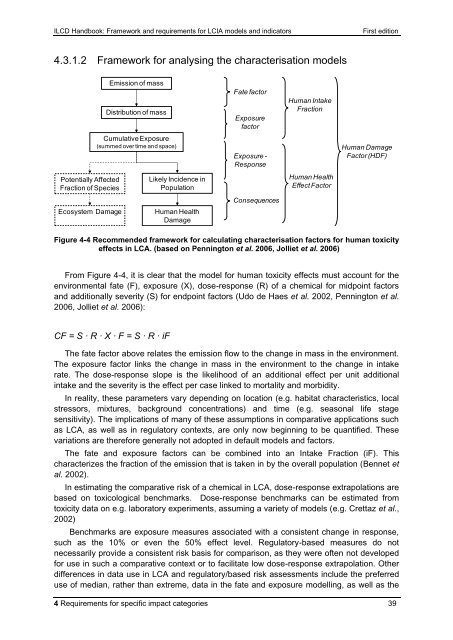ILCD Handbook: Framework and requirements for LCIA models and ...
ILCD Handbook: Framework and requirements for LCIA models and ...
ILCD Handbook: Framework and requirements for LCIA models and ...
You also want an ePaper? Increase the reach of your titles
YUMPU automatically turns print PDFs into web optimized ePapers that Google loves.
<strong>ILCD</strong> <strong>H<strong>and</strong>book</strong>: <strong>Framework</strong> <strong>and</strong> <strong>requirements</strong> <strong>for</strong> <strong>LCIA</strong> <strong>models</strong> <strong>and</strong> indicators First edition<br />
4.3.1.2 <strong>Framework</strong> <strong>for</strong> analysing the characterisation <strong>models</strong><br />
Potentially Affected<br />
Fraction of Species<br />
Ecosystem Damage<br />
Emission of mass<br />
Distribution of mass<br />
Cumulative Exposure<br />
(summed over time <strong>and</strong> space)<br />
Likely Incidence in<br />
Population<br />
Human Health<br />
Damage<br />
Fate factor<br />
Exposure<br />
factor<br />
Exposure -<br />
Response<br />
Consequences<br />
Human Intake<br />
Fraction<br />
Human Health<br />
Effect Factor<br />
Human Damage<br />
Factor (HDF)<br />
Figure 4-4 Recommended framework <strong>for</strong> calculating characterisation factors <strong>for</strong> human toxicity<br />
effects in LCA. (based on Pennington et al. 2006, Jolliet et al. 2006)<br />
From Figure 4-4, it is clear that the model <strong>for</strong> human toxicity effects must account <strong>for</strong> the<br />
environmental fate (F), exposure (X), dose-response (R) of a chemical <strong>for</strong> midpoint factors<br />
<strong>and</strong> additionally severity (S) <strong>for</strong> endpoint factors (Udo de Haes et al. 2002, Pennington et al.<br />
2006, Jolliet et al. 2006):<br />
CF = S · R · X · F = S · R · iF<br />
The fate factor above relates the emission flow to the change in mass in the environment.<br />
The exposure factor links the change in mass in the environment to the change in intake<br />
rate. The dose-response slope is the likelihood of an additional effect per unit additional<br />
intake <strong>and</strong> the severity is the effect per case linked to mortality <strong>and</strong> morbidity.<br />
In reality, these parameters vary depending on location (e.g. habitat characteristics, local<br />
stressors, mixtures, background concentrations) <strong>and</strong> time (e.g. seasonal life stage<br />
sensitivity). The implications of many of these assumptions in comparative applications such<br />
as LCA, as well as in regulatory contexts, are only now beginning to be quantified. These<br />
variations are there<strong>for</strong>e generally not adopted in default <strong>models</strong> <strong>and</strong> factors.<br />
The fate <strong>and</strong> exposure factors can be combined into an Intake Fraction (iF). This<br />
characterizes the fraction of the emission that is taken in by the overall population (Bennet et<br />
al. 2002).<br />
In estimating the comparative risk of a chemical in LCA, dose-response extrapolations are<br />
based on toxicological benchmarks. Dose-response benchmarks can be estimated from<br />
toxicity data on e.g. laboratory experiments, assuming a variety of <strong>models</strong> (e.g. Crettaz et al.,<br />
2002)<br />
Benchmarks are exposure measures associated with a consistent change in response,<br />
such as the 10% or even the 50% effect level. Regulatory-based measures do not<br />
necessarily provide a consistent risk basis <strong>for</strong> comparison, as they were often not developed<br />
<strong>for</strong> use in such a comparative context or to facilitate low dose-response extrapolation. Other<br />
differences in data use in LCA <strong>and</strong> regulatory/based risk assessments include the preferred<br />
use of median, rather than extreme, data in the fate <strong>and</strong> exposure modelling, as well as the<br />
4 Requirements <strong>for</strong> specific impact categories 39



